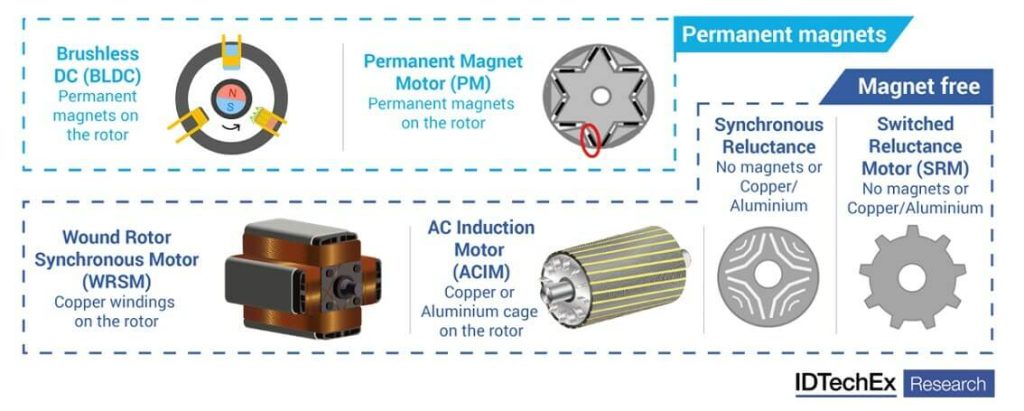The European Commission has proposed the Critical Raw Materials Act to “ensure the EU’s access to a secure, diversified, affordable and sustainable supply of critical raw materials”. This act could have big implications for various technologies and markets, but one that is growing rapidly with a heavy reliance on critical raw materials is the electric vehicle (EV) market, specifically electric motors. IDTechEx predicts that yearly demand for rare earth magnets in EV motors will surpass 1 billion kg by 2031. In which case, what impact will this new act have within the EV market?
Europe is extremely dependent on other regions to source and process strategic raw materials; one category highlighted in the act is rare earth elements for magnets, including Nd, Pr, Tb, Dy, Gd, Sm, and Ce. Much of the act focuses on upping the EUs extraction (10% from 3% now), processing and refining (40%), and recycling (15%) of these materials. The act acknowledges that the EU cannot be self-sufficient in this regard but targets that it shall not rely on any specific country for more than 65% of any individual strategic raw material.

Electric motors in EVs heavily utilize rare earth magnets. In 2022, 82% of the electric car market globally was using rare earth based permanent magnet (PM) motors. There are alternative strategies, with European OEMs like Renault, BMW, Mercedes, and Audi presenting magnet free technologies, including wound rotor motors and induction motors. However, IDTechEx’s research found that their market share in 2022 was less than 23% in Europe (the region with the greatest OEM focus on magnet free motors).
In regards to the recycling and magnet content rules, the act sets responsibility on the entity that places the motor vehicle or light means of transport on the market. They must indicate whether they contain PMs, the family of PM (NdFeB, SmCo, AlNiCo, Ferrite), and the location of the electric motors within the vehicle, with steps to remove them.
This should help recyclers when it comes time to process motors at the end of life. For cases where the PM content exceeds 0.2kg (electric car PM motors are typically 1-3kg), the share of Nd, Dy, Pr, Tb, B, Sm, Ni, and Co that has been recovered from post-consumer waste shall be made public information. The specific shares of recycled content required are yet to be set.
While the act sets out targets to reduce the EU’s reliance on imported materials, critically, it does not set out how this could be achieved on the demand side. For example, some OEMs may use a magnet free option that greatly reduces the demand for rare earths, but another may not, which has not been reflected in the act. The fact that an OEM not using PMs will not have to declare or be concerned with the recycled content of its magnets is unlikely to be a key driver of OM content reduction. A reduction in PM content per motor or greater adoption of smaller vehicles would also reduce demand, easing the demand, but this is again not accounted for.
The LEVA-EU (Light Electric Vehicle Association) has pointed out in its feedback to the EU Commission that the 0.2kg magnet weight will mean that some vehicle classes, like electric cycles, will be excluded, but a series hybrid cycle may not be. This makes it harder for certain technologies or companies to operate. It also highlights that the supply of components for LEVs (light electric vehicles) is already insufficient, and so companies (especially SMEs) have less choice on where their components are sourced. This act may discriminate against companies sourcing parts from the EU vs non-EU regions.
In IDTechEx’s opinion, the EU Critical Raw Materials Act in its current form will have little impact on the adoption of magnet free motor designs in most EV categories, with initial cost and price volatility of the materials being a much larger driver. However, the act should start to push greater focus onto the recycling of rare earths, which currently only happens on a very small scale.
In a market where motors are in greater supply, higher recycled contents or magnet free designs could become a differentiation point for motor manufacturers selling in the EU. But in the opposite case of components being in short supply, this makes it harder for the final vehicle producer if it wishes to comply with the new proposed act.
